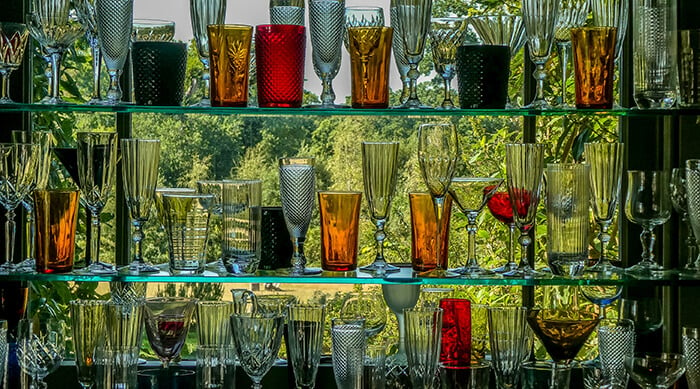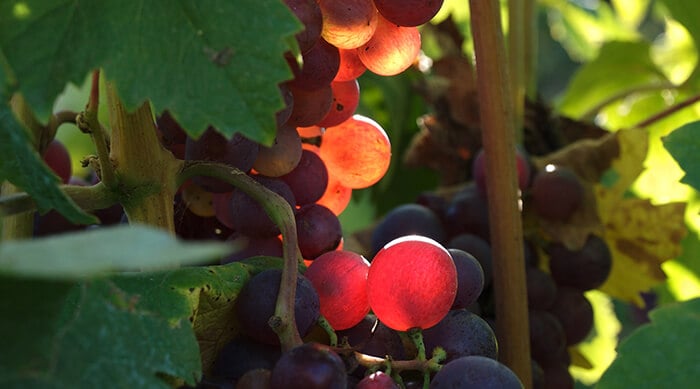Table of Contents
Why Sugar is Vital to Winemaking
What if your wine’s sugar content isn’t listed on the bottle?
What kind of sugar is in wine?
Sugar in Wine Compared to Cocktails and Liquor
How much sugar is in wine?
Let’s get down to basics. All wines have some residual sugar, the major source of a wine’s sugar content. From there, sugar in wine depends on the type of wine you’re sipping.
In general, most dry red and white wines only have about a gram of sugar per standard 5 oz serving. To keep things in perspective, there are 39 g of sugar in a single can of regular Coca-Cola.
What wine is lowest in sugar? Wines that are lowest in sugar are dry wines and sparkling wines.
Some wine brands now market themselves as low-sugar options, but you won’t likely see sugar levels — or any nutrition facts — on a bottle of wine.
So what’s a health-conscious wine lover to do?
You just need to know the lingo and how to spot the sweet stuff while shopping to stock your wine cellar. Let’s dig a little deeper into the types of wine you should seek if you’re watching your sugar intake.
Here’s a breakdown of grams of sugar per bottle of wine and per glass of wine. The sweeter varietals offer broader ranges of sugar content.
| Sweetness | Sugar Content per Bottle | Sugar Content per Glass | Varietals |
| Very dry or bone dry | <1 g | <1 g | Sauvignon Blanc, Lambrusco (secco), Champagne (extra brut) |
| Dry | 1-7 g | <1-1.4 g | Pinot noir, Chardonnay, Cabernet Sauvignon |
| Off-dry | 7-26 g | 1.4-5 g | Gewürztraminer, White Zinfandel, Chenin Blanc |
| Sweet | 26-90 g | 5-18 g | Sweet Rosé styles, e.g. Pink Moscato, Sweet Riesling |
| Very sweet | 90-165 g | 18-33 g | Sauternes, Port, Ice Wine |
The amount of sugar in wine is directly related to carbohydrates. Sugars are carbs, after all. The higher the sugar content, the more carbs and wine calories you consume with each glass. If you’re on a low-carb diet like keto, any low-carb wines you seek out will also be lower in sugar.
Read Next: The Dos and Don'ts of Mixing Wine and Tylenol
Why Sugar is Vital to Winemaking
Without sugar, we wouldn’t have any wine. Sugar in wine is naturally-occuring as part of the fermentation process.
During fermentation, added yeast breaks down the sugars from wine grapes and turns those sugars into alcohol, or ethanol. In dry red wines and dry whites, there isn’t much left over, but whatever sugars do remain are called residual sugars.
Some wineries add sugars at some point in the fermentation process to adjust for flavor. You’ll often see this in lower-quality wines, so if you’re buying wine based on price alone, expect some of those sweetening tricks.
Others specialize in sweeter varietals that are purposefully high in sugar and often higher in alcohol content. Fortified wines like port, for example, can have an alcohol by volume (ABV) of around 20% and 8 g of sugar in just one serving.
Late harvest wines can also be notoriously sweet. These wines come from grapes that have been left on the vine for longer than most. They might even look like raisins at the end of the day.
What if your wine’s sugar content isn’t listed on the bottle?
Let’s be real. Wine labels aren’t known for being transparent with their nutritional information.
You probably won’t see much on that bottle of wine other than the grape blend, the wine’s origins, and the vintage. That all may be helpful if you’re into aging wines, but it doesn’t really help you choose the healthiest options.
Read Next: How Long Does Unopened Wine Last?
That’s where your knowledge of wine tasting notes comes in. You’re looking for words that suggest sugar and sweetness levels in wine. Anything with “dessert” on the label is a no-go and an obvious indicator of sweet wines. Look for the word “dry,” instead.
What does it mean if a wine is "dry"? When a wine is “dry,” that means it has little to no residual sugar. It can also refer to the mouthfeel of a wine, but a wine’s tannins are usually more responsible for that astringent sensation on your tongue.
Here’s a quick language lesson: If you want a dry champagne, look for “brut” on the label. Brut is French for dry.
Acidity is also a good indicator of sugar content in wine. Crisp whites like sauvignon blanc that make your lips pucker typically have less sugar per ounce while maintaining that fresh, fruity aftertaste.
What kind of sugar is in wine?
We already told you all about what happens during fermentation. The natural sugars in wine are converted into alcohol. The leftover sugar in wine is called residual sugar. As far as the type of sugars in wine, we’ll need to look to the grapes for that.
Without fermentation, those smashed grapes would just be grape juice.
What type of sugars are in wine? The type of sugars in wine are the natural sugars glucose and fructose. Fructose is the sugar found in fruits like grapes. It’s sweeter than glucose, and often used as an artifical sweetener.
Sugar in Wine Compared to Cocktails and Liquor
Dry wines don’t have less sugar than a lot of alcoholic beverages out there. While you won’t get any sugar at all in a shot of distilled spirits like vodka, gin, or tequila, things can get dicey when you get to mixed drinks.
The sugar content of a dry wine doesn’t compare to some popular cocktails, especially if you’re adding sugary mixers. A classic margarita can have up to 12 g of sugar. If frozen daiquiris are your fave, know that you’re sipping about 23 g of sugar out of that swirling machine.
If you want to enjoy cocktails with without worrying about sugar, replace colas and fruit juices with calorie-free sodas. Cocktails like dirty martinis without many sweetening additives only have about half a gram of sugar per serving.
Read Next: Why Wine Causes Bloating & How to Prevent It
The Wine/Diabetes Connection
Moderate wine consumption can be a healthy part of your diet if you have diabetes, as long as you’re taking steps to regulate your blood glucose levels. Anything beyond that and you put yourself at risk for weight gain, insulin resistance, and other health complications.
Too much alcohol can also interfere with your diabetes medication and cause unexpected side effects.
There are some positives to a glass of wine here and there with diabetes. Drinking moderately can decrease your risk of developing type 2 diabetes in the first place, along with improving cardiometabolic outcomes.
Red wine in particular boasts anti-inflammatory properties thanks its resveratrol content. Resveratrol has been linked to improving a variety of health conditions, including diabetes.
If you’re watching your alcohol content, you can get a good dose of reseveratrol from eating grapes, blueberries, and peanuts. Non-alcoholic red wines like Surely pinot noir are another option for your resveratrol boost.
The important thing to note about diabetes and wine is that you know exactly what’s in your glass. Dessert wines or wines with added sugar are best avoided.
Drinking Wine On a Low-Sugar Diet
You can drink wine on a low-sugar diet. Dry red wines are often the wine of choice for anyone watching their carbs or sugars. White wines are good, too, but they have less antioxidant activity than red wines.
Any potential benefits of red wine and other varietals quickly decrease the more you consume, though. Moderate drinking is defined as a single standard serving of wine per day for women and up to 2 glasses of wine per day for men.
Serving sizes are also important if you’re watching your sugar, carbs, and calories. That’s just 5 oz of wine per glass. If you treat yourself to a more generous pour, you’ll need to account for that as you monitor your sugar consumption.
How much sugar is in an 8 oz glass of wine? There is about 1.6-1.8 g of sugar in an 8 oz glass of dry wine. A bottle of wine starts at about 5 g of sugar if you’re choosing dry varietals.
Read Next: How to Make a Non-Alcoholic Red Wine Spritz
Low-sugar, alcohol-free wine exists. (Yes, we’re serious!)
If you’re really getting serious about sugars and your health, abstaining from alcohol altogether is always an option. The best wine for you will always be a non-alcoholic wine. Surely non-alcoholic brut has 0 grams of added sugar without sacrificing any bubbles.
Our wines are low-calorie, too. No matter how much resveratrol you’re sipping on, alcohol is still considered empty calories. If you’re ready for something light and bright, try our non-alcoholic sparkling rosé with just 20 calories in an 8 oz serving.

![Sugar in Wine by Type [Plus, Sugar in Winemaking]](https://dropinblog.net/cdn-cgi/image/fit=scale-down,width=700/34240221/files/featured/sugar-in-wine.jpg)


![Do You Refrigerate Wine? [Guide to Reds vs. Whites]](https://dropinblog.net/cdn-cgi/image/fit=scale-down,width=700/34240221/files/featured/do-you-refrigerate-wine.jpg)